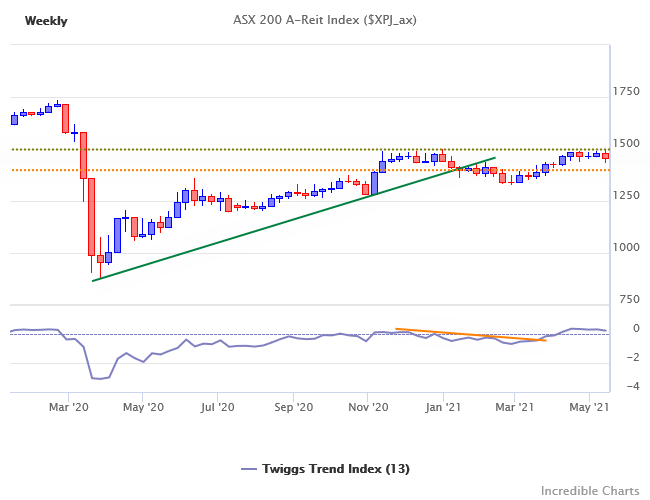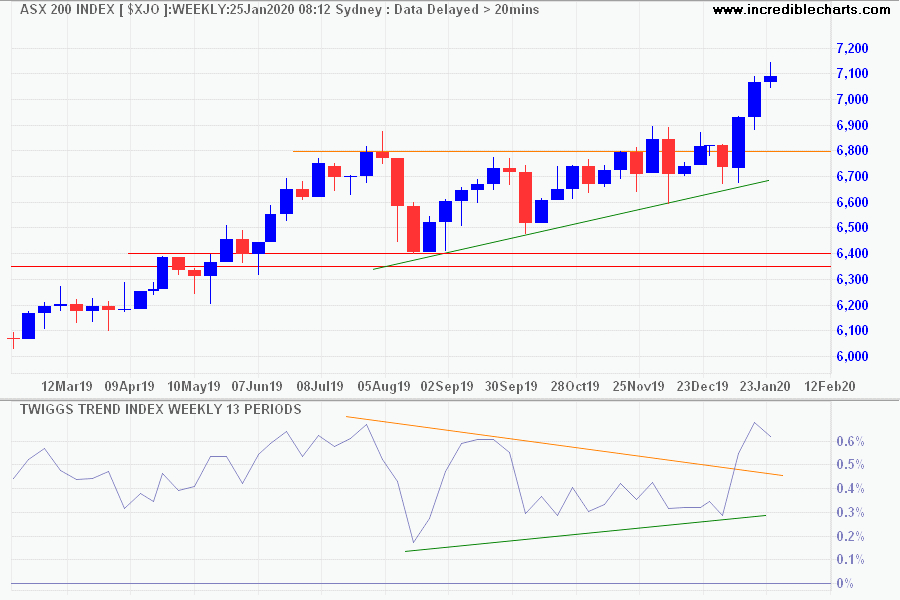The ASX 200 continues to test its February 2020 high at 7200. Narrow consolidation below resistance is a bullish sign but we need to keep a weather eye on the US and China.

Financial Markets
Bond ETFs, in a sideways consolidation, indicate that long-term interest rates are holding steady. Inflation remains muted and the RBA is following through on their stated intention to suppress long-term yields.

A-REITs are testing resistance at 1500. Reversal below 1340 is unlikely but would warn of a double-top reversal.

Financials are testing resistance at 6500. A rising 13-week Trend Index — with troughs above zero — flags buying pressure, suggesting that a breakout is likely.

Health Care, Discretionary & Technology
Health Care is testing resistance at 42500. The rising Trend Index is bullish but failure to cross above zero would confirm long-term selling pressure. Breach of 40000 would complete a bull-trap (a bear signal for investors) and warn of another test of primary support at 37500.

Technology broke support at 1900 to signal a primary down-trend, imitating the pattern in US markets. Breach offers a medium-term target of 14001.

Consumer Discretionary is testing its rising trendline. We expect a test of support at 2900 as the impact of government stimulus fades.

Mining
Iron ore retreated slightly, to $210/metric ton. Chinese steel mills are stockpiling — due to rising tensions with Australia and anticipated production curbs in China (to reduce pollution levels). The boom is only expected to last as long as stockpiling continues. Then prices are likely to fall steeply as mills run down stockpiles. Reversal below support at $175-$180 would warn of a sharp decline.

The ASX 300 Metals & Mining found resistance at 6000. A tall shadow on this week’s candle warns of short-term selling pressure. Another test of support at 5000 is likely.

The All Ordinaries Gold Index (XGD) continues to test its new support level at 7000. Follow-through below recent lows would warn of another test of 6000, while recovery above 7300 would signal a fresh advance. Breakout above the long-term descending trendline would strengthen the bull signal. Gold bullishness is fueled by rising inflation fears.

The Gold price, in Australian Dollars, is testing its descending trendline and resistance at 2400. Breakout above the two would deliver a strong bull signal.

Conclusion
Technology stocks have commenced a primary down-trend. Metals & Mining look highly-priced and susceptible to a sharp reversal. They have looked that way for months but sooner or later we are bound to see a rapid re-pricing.
Steady long-term interest rates and a buoyant housing market are lifting REITs and Financials respectively. Health Care and Consumer Discretionary look hesitant, while Gold stocks are making a tentative rally.
Notes
- Target for XIJ is its 2400 peak extended below 1900.























































